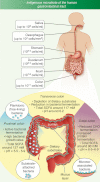Intestinal colonization resistance
- PMID: 23240815
- PMCID: PMC3533696
- DOI: 10.1111/j.1365-2567.2012.03616.x
Intestinal colonization resistance
Abstract
Dense, complex microbial communities, collectively termed the microbiota, occupy a diverse array of niches along the length of the mammalian intestinal tract. During health and in the absence of antibiotic exposure the microbiota can effectively inhibit colonization and overgrowth by invading microbes such as pathogens. This phenomenon is called 'colonization resistance' and is associated with a stable and diverse microbiota in tandem with a controlled lack of inflammation, and involves specific interactions between the mucosal immune system and the microbiota. Here we overview the microbial ecology of the healthy mammalian intestinal tract and highlight the microbe-microbe and microbe-host interactions that promote colonization resistance. Emerging themes highlight immunological (T helper type 17/regulatory T-cell balance), microbiota (diverse and abundant) and metabolic (short-chain fatty acid) signatures of intestinal health and colonization resistance. Intestinal pathogens use specific virulence factors or exploit antibiotic use to subvert colonization resistance for their own benefit by triggering inflammation to disrupt the harmony of the intestinal ecosystem. A holistic view that incorporates immunological and microbiological facets of the intestinal ecosystem should facilitate the development of immunomodulatory and microbe-modulatory therapies that promote intestinal homeostasis and colonization resistance.
© 2012 Blackwell Publishing Ltd.
Figures


References
-
- Renz H, Brandtzaeg P, Hornef M. The impact of perinatal immune development on mucosal homeostasis and chronic inflammation. Nat Rev Immunol. 2011;12:9–23. - PubMed
-
- Leser TD, Molbak L. Better living through microbial action: the benefits of the mammalian gastrointestinal microbiota on the host. Environ Microbiol. 2009;11:2194–206. - PubMed
-
- Eberl G. A new vision of immunity: homeostasis of the superorganism. Mucosal Immunol. 2010;3:450–60. - PubMed
Publication types
MeSH terms
Grants and funding
LinkOut - more resources
Full Text Sources
Other Literature Sources

